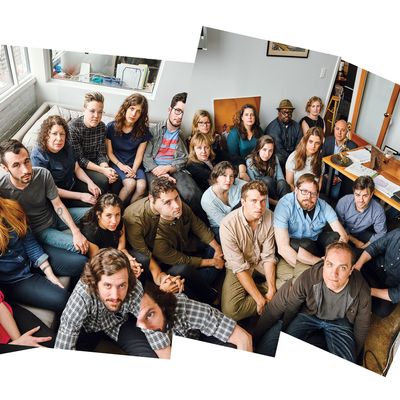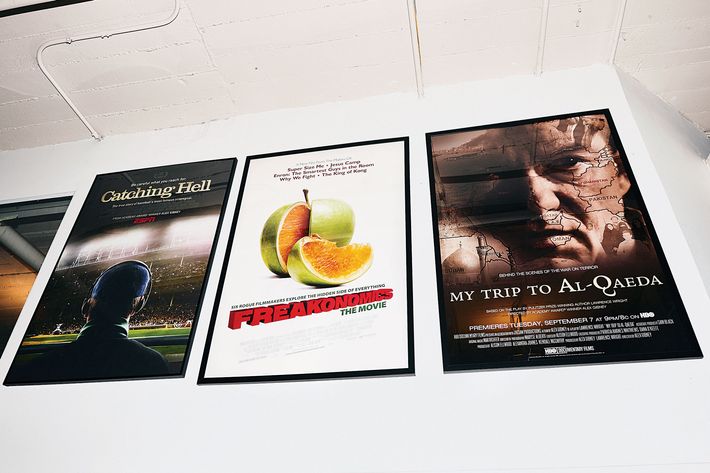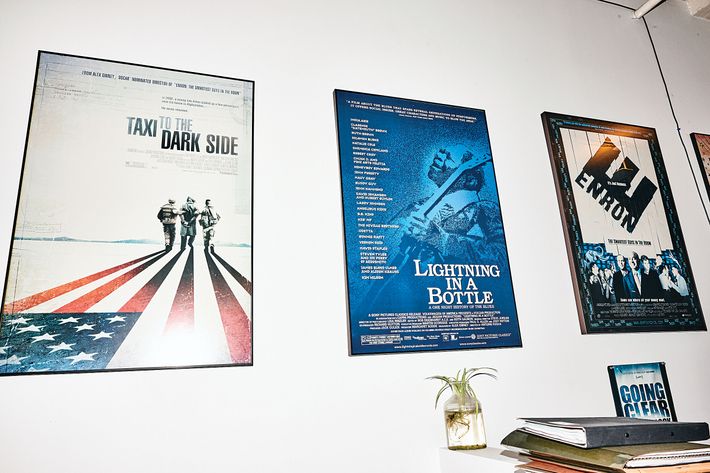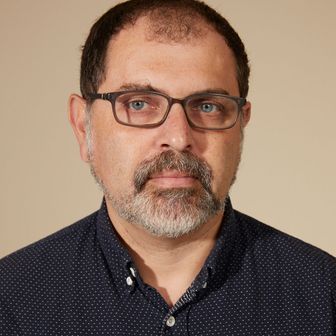
Alex Gibney’s first movie came out 11 years ago. He’s since directed 27 more, which in the slow-burn medium of documentary film might be unprecedented; it beats the average director’s pace by a factor of six or seven. Enron: The Smartest Guys in the Room, the movie that launched his blitzkrieg career, opens with a camera panning up on Enron’s gleaming cylindrical office tower as Tom Waits asks, in a sinister growl, “What’s he building in there? What the hell is he building in there?”
Anyone who’s seen even a fraction of Gibney’s work might wonder the same thing about his company, Jigsaw Productions, located on the 17th floor of the enormous Starrett-Lehigh Building in West Chelsea, where he employs a hundred-odd full- and part-time collaborators. “It used to be they kept cattle up there,” says the journalist Lawrence Wright, Gibney’s friend and collaborator on Going Clear, My Trip to Al Qaeda, and a forthcoming fictionalization of Wright’s The Looming Tower. “It’s truly an industrial building, and Alex has created a kind of documentary factory.”
Gibney’s churn may be relentless — investigative features, PBS specials, ESPN shorts, Netflix food porn, HBO music bios, a CNN docuseries, a New Yorker video supplement for Amazon — but it’s probably best not to use that analogy in his presence. “Factory isn’t a fair way of describing it,” says Marc Shmuger, the former Universal Pictures chairman who produced We Steal Secrets: The Story of WikiLeaks as well as Zero Days, a terrifying new exposé of cyberwarfare that opens in July. “I would call it a studio — a vision of what original studios were doing when they started telling narrative stories.”
A concrete-floored warren of desks and drywall punctuated by gridded views of the Hudson River, Jigsaw feels like a cross between a recording studio and the headquarters of a well-funded literary journal. There’s an air of bustle and disarray, owing partly to Jigsaw’s impending move, after years of growth, to a new building downtown. “Right opposite the Wall Street bull,” Gibney tells me, cracking a gap-toothed smile, after greeting me in his office. When I tell him it seems a little small for the king of documentaries, he replies, “It is the king of documentaries, after all.”
Unless you’re Michael Moore or Morgan Spurlock or maybe Gibney, documentaries have not made you rich and probably never will. Fiction’s poor stepchild since the days of the Lumières, the format has historically depended on the questionable goodwill of governments and sponsors. But something did start to change around 2002: Movies as diverse as Spellbound, Bowling for Columbine, and Super Size Me began to make real money, and reality TV began hooking viewers on nonfiction stories high and low. The genre’s real accelerant was the streaming boom, liberating documentaries from the need to compete for stadium seating with The Avengers in 3-D.
The boom also gave documentarians a broad new platform for the kind of entertainment we once called “journalism.” Gibney makes a lot of it; Jigsaw’s fearsome pace and deep bench of researchers give his documentaries the authority of first-draft history. You can watch him root out political corruption in Enron and Casino Jack, personal corruption in Client 9 and The Armstrong Lie, clerical abuse in Going Clear and Mea Maxima Culpa, and military abuse in Taxi to the Dark Side and We Steal Secrets. In Zero Days, you see him dissect the computer worm Stuxnet, which destroyed Iran’s centrifuges, to reveal a vast, secret cyberarms race. At his best, Gibney is not just an investigator or a crusader or an artist, but some rare hybrid of the three — animated by narrative imperatives, driven to expose the secrets of the powerful, and expert at using the first to deliver the second to as many people as possible.
“Documentaries have risen in importance as journalism has gone through a very difficult last 20 years,” says Wright. “If you’re working with a fine filmmaker who can get it into the right channels, compared to the number of people that read your book, it’s tenfold or a hundredfold … Maybe, if we lived in a time when newspapers and magazines were more vigorous, we might not see the dependence on filmmakers like Alex. But it could just simply be that people want to see their stories more visually.”
Gibney calls himself “a filmmaker with journalistic baggage” rather than a journalist — “I’m interested in making movies that play like movies.” He definitely speaks the language: At the Peabody Awards in early June, I watched him sit next to The Jinx director Andrew Jarecki, secure an L.A. meeting with Amazon executive Joe Lewis, and schmooze with Sheila Nevins, his HBO producer, all of this the day after his son’s wedding. But for all his studio relationships, Gibney’s most important contacts may still be journalists. Jigsaw produces Amazon’s The New Yorker Presents with that magazine, which publishes Wright; Enron: The Smartest Guys in the Room was based on a book of the same name, and one of its co-writers went on to do a book in tandem with the Eliot Spitzer movie, Client 9.
You could even argue that Jigsaw works like a newsroom. (It was named for the “jigsaw classroom” concept, wherein a team of students employs diverse talents to complete a project.) The company has a COO with his own staff, a director of physical production, a development team — 12 full-time employees and up to 100 more in rotation. Gibney’s son Nick, the newlywed, directs graphics and animation. Each documentary has its own dedicated team headed by a showrunner or producer. The roles are fluid — editors become producers, producers directors — but Gibney, the executive producer, always presides.
“Executive producer” is a famously elastic title, and Gibney’s critics and even some admirers wonder whether he presides quite enough, especially over cultural documentaries that bear a little less of his personal stamp. On the wall of his office is a framed 1982 letter from Luis Buñuel turning down Gibney’s request for an interview. “There’s a period where he did nothing but produce,” says Gibney, “and I think that enabled him to be a really good director.” Gibney, 62, was mostly a producer into middle age, and he scoffs at the idea that Jigsaw’s busy workflow gives some movies short shrift. “If we can do a number of different projects at once, I can take the time to get them right,” he says. “It’s the opposite of an assembly line … Somebody called me the Fassbinder of documentaries, so I’m cool with that. Not all of Fassbinder’s films were great, but they were all interesting and some of them were great. Yeah, he was prolific, but he was always working. And by the way, sometimes if you work a lot, you learn shit!”

Gibney’s father, Frank, was a newsman, a Japan specialist who “liked to joke about how many times he got fired” — mainly, according to Alex, for reversing the rules of success: “He sucked down and kicked up.” Alex was born in Manhattan in 1953. His first memory is of sitting in a high chair while his mother and father screamed at each other. They divorced soon after. He believes it instilled in him an impulse to pacify and empathize, which served him well in cozying up to touchy subjects like Lance Armstrong. “I wanted everybody to feel good,” says Gibney. “It took me a long time to learn how to fight.”
After the divorce, Harriet Gibney moved with Alex and his sister to Cambridge, Massachusetts, and later married the legendary leftist clergyman William Sloane Coffin (CIA agent, peace activist, civil-rights champion). The new couple’s own drunken fights are well documented, but Gibney prefers to dwell on their moral righteousness. He likes to talk about how his mother not only let young Alex buy a boa constrictor but on one occasion wore it around her neck to scare off some “boring white” dinner guests.
At boarding school and Yale, Gibney studied Japanese like his father. But he soon fell under the sway of the Maysles brothers and other documentarian-auteurs who infused journalism with artistry and flair: “The idea of being able to project images for millions of people, that was somehow much more engaging for me.” After college he went to film school — “UCLA refers to me now, but I never actually graduated” — and made an early documentary of his own, The Ruling Classroom, about a school democracy experiment gone wrong. Then, unsure what to do with his convictions and his opportunities, he floundered. He got a job editing movies for the Samuel Goldwyn Company, producer of arty flicks alongside B-movies like Invasion of the Bee Girls. Samuel Goldwyn Jr., a friend of Frank Gibney’s, offered him an executive job in distribution, which he turned down. “I was reading a lot of Marxist theoreticians at the time,” he says. “I desperately wanted to be a worker.” He also tried to unionize the shop and left soon thereafter.
Frank Gibney didn’t get his son’s passion. He tried to wrangle him interviews with Time and Newsweek, but Alex demurred. Eventually they did work together, producing a book and a documentary series called Pacific Century (Gibney’s first collaboration with a writer). “It was pretty good,” Gibney says. “But I waited for the phone to ring, and waited and waited.” During the ’90s, he cobbled together production and editing work and directed a couple of TV mini-series. But at a time when television was considered either homework or hackwork, film features eluded him. He had turned 50 before he made Enron. “It was hard, because I never had a mentor,” Gibney says. His first one turned out to be Wim Wenders, who directed one film in the Gibney-produced PBS series The Blues. From Wenders, he says, he learned that you might as well try anything: Why not open a blues documentary in outer space? But he was also put off by Wenders’s auteuristic perfectionism: “I would have paid a little less attention to the lights and more attention to what was going on” as the cameras rolled.
Enron, which was nominated for an Oscar, shows a filmmaker still figuring out that balance. He toyed with the idea of doing it as a musical scored and narrated entirely by Tom Waits. He was also scrambling to finish it without going bankrupt. I ask him if that was why he made two movies that year about milquetoast rockers 3 Doors Down. “How did you guess?” he says. For-hire promotional documentaries are one way to balance the books (see Spurlock’s One Direction: This Is Us); another is commercial work, which auteurs like Errol Morris and the Maysles brothers have done (for banks and Taco Bell, for instance).
Gibney’s avoided both paths, mostly by taking on a lot more work, in many more styles, than the average filmmaker. That makes him an impresario for this all-you-can-eat era, when a form once relegated to PBS broccoli and the occasional masterpiece has sprouted almost as many genres as fiction has (three years ago, our film critic, David Edelstein, named 17 of them in this magazine). Ari Folman’s Waltz With Bashir was completely animated, and graphics now weave together many an otherwise static narrative. Asif Kapadia’s Amy employed a heartbreaking montage of paparazzi shots, home videos, and selfies — the archives in our pockets. Documentaries can use actors or stagy “re-creations” (the aesthetically correct term for reenactments) or maybe even borderline fiction, like the possible put-on Exit Through the Gift Shop. Gibney thinks of his new movie as a globe-trotting thriller, “like in the Bourne movies,” and he compares most of his films to fiction genres — Enron is “a heist movie,” Taxi to the Dark Side a murder mystery.
He says that Taxi, which investigates detainee abuse by American soldiers at Bagram Airbase in Afghanistan, was a turning point, making him into a deeper and darker filmmaker. It also brought him closer to his father, a former World War II interrogator who urged him to pursue the story, and to a generation more intimately familiar with the horrors they were protesting against. His father and stepfather both died during the making of the movie. Frank didn’t see it win an Oscar, but “by the time he was dying, he was starting to get it.”
Taxi is also the first film narrated by Gibney. In person, Gibney is given to very dark wit, but as an interrogator he is unfailingly earnest — a world-weary but even-keeled narrator flaring up only when a stonewalling source is “beginning to really piss me off.” And he keeps his voice low in the mix. “If you look at 60 Minutes, the correspondent is louder than the subject,” he says. “I think it serves a purpose to have the emphasis on the subjects.” (Update: A producer for 60 Minutes tell us the voices of correspondents are not mixed louder than interview subjects.)
“I’ve called him the documentary’s greatest prosecutor,” says A. J. Schnack, a filmmaker currently working for the Intercept’s documentary unit, Field of Vision. “His films are the perfect closing arguments. He starts with maybe a small story that doesn’t seem necessarily related to the larger thesis and he just gets bigger and bigger.”

Gibney’s investigative documentaries tend to share a structure and a tone. Binge-watch them and they start to bleed into each other — one long, smoothly segued cascade of talking heads, found footage, and astonishing revelations. “Sometimes Alex winds up competing with himself, especially when it comes down to the world of awards,” says Thom Powers, the Toronto Film Festival’s director of documentary programming. “Last year he had both Steve Jobs and Going Clear. In 2013, he had both The Armstrong Lie and We Steal Secrets. It is a little too much for people to absorb — the kinds of people who evaluate a career. Comparable in the world of fiction would be Joyce Carol Oates.” Others have brought up Jeff Koons.
Yet it’s hard to imagine Zero Days being made by anyone else. Marc Shmuger pitched Gibney a film on the mystery of the Stuxnet worm during their collaboration on We Steal Secrets, which dealt with similar challenges (scant sources, hard-to-explain technology, ambiguous politics). Shmuger’s history with Universal helped secure a part of the approximately $2 million budget — unusually high for a documentary. He “also had a unique contact with access to some valuable and publicly unavailable information,” Gibney says cryptically.
Then Gibney built his team. Javier Botero, a former intern with a programming background, “wrote a magnificent treatment that helped us get the financing.” Botero also tracked down interview subjects and talked through Stuxnet’s dense code with cybersecurity experts. Gibney’s producer, Sarah Dowland, had conveniently been a visual-effects producer at Framestore, the source of Secrets’ high-end graphics (“I’m their loss leader,” Gibney says). Andy Grieve was a natural fit to edit the project; he’s worked on dark material like Secrets, Armstrong, and Going Clear. Researcher Grace Fardella led a small team tracking down archives, including an opening-sequence re-creation of a nuclear scientist’s assassination taken from an Iranian film. And Gibney again reached out to a friendly journalist, David Sanger of the New York Times. Sanger made Zero Days’ Berlin premiere front-page news — a good scoop for him and great publicity for Gibney.
The story, shrouded and overclassified in the U.S., broke open when Gibney went to Israel. He defied Dowland’s direct warning not to film the Dimona nuclear facility (Israel has never publicly confirmed that it has a nuclear-weapons program). He only used about a second of that footage, “but it was important for me to put it in. I was just offended at the idea that we couldn’t shoot that.”
At times they felt they were close to getting an NSA source on the record or permission to film in Iran. But Gibney is accustomed to working around a lack of access. He never got Julian Assange or Jack Abramoff on-camera, and his only interaction with active Scientologists was via legal threats and public confrontations. It’s never stopped him from finishing a movie.
One morning, Gibney came into the office with the idea of “the character” — a digital rendering of an actress performing a collage of deep-background transcripts spilling national-security secrets. Built by a design firm that rarely works on movies, “the character” twitches with a varying proportion of dots, lines, and flesh in what looks like four dimensions. It was both a kind of re-creation of investigative print journalism (particularly the anonymous quote) and an attack on the movie’s central problem: “There was no main character.” Even the grandest Gibney indictments turn on human moments — Chelsea Manning’s betrayer breaking down, a deaf man confronting his childhood abuser. “This doesn’t have that gutbucket moment,” says Gibney. “But what you’re cascading on is adrenaline and a sense of increasing fear, glimpsing this universe that’s very hostile.” “The character” is intentionally alienating, and Gibney’s device has already divided critics. One loved the “cloak-and-dagger dimension” while another called it an “unnecessary coup de theatre.” Neither acknowledged the real innovation, though. In a singular vision brought to life by dozens of people, Jigsaw had just reinvented the talking head. And found a whole new way to break news.
*This article appears in the June 27, 2016 issue of New York Magazine.





